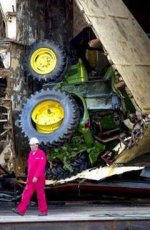You are using an out of date browser. It may not display this or other websites correctly.
You should upgrade or use an alternative browser.
You should upgrade or use an alternative browser.
Be careful on your boat!
- Thread starter 8NTX
- Start date
- Views: 1726
/ Be careful on your boat!
#1
tracdoc
Platinum Member
Steve,
What an incredible site!
When I went to the description of one of the disasters, the "Tricolor" in the English Channel Click Here , my curiosity was piqued,so I clicked on one of the pics to go to the salvage operation. It was all in Dutch, but the pics spoke for themselves.
The salvage operation Click Here showed them literally sawing up the hull, cargo and all. You could see demolished new Volvos, BMWs, etc., and even a John Deere tractor. I've attached the tractor photo. I can't tell which model it is, but what a loss. Luckily, it appears that this collision did not involve any loss of life, just big bucks and pride.
What an incredible site!
When I went to the description of one of the disasters, the "Tricolor" in the English Channel Click Here , my curiosity was piqued,so I clicked on one of the pics to go to the salvage operation. It was all in Dutch, but the pics spoke for themselves.
The salvage operation Click Here showed them literally sawing up the hull, cargo and all. You could see demolished new Volvos, BMWs, etc., and even a John Deere tractor. I've attached the tractor photo. I can't tell which model it is, but what a loss. Luckily, it appears that this collision did not involve any loss of life, just big bucks and pride.
Attachments
Dutch445
Elite Member
One site I read said that they used chain as a saw to cut the ship into sections, then lifted them on the barges to transport them back to port.
Dutch445
Elite Member
imported_OWDouglas
Silver Member
interesting site...thanks
btolle
Platinum Member
Preparations photo #5 shows a close up of the cutting cable they used.
"What is the cutting wire made of and how exactly does it work?
The cutting wire consists of a series of grit-covered bushes mounted along a high-tension steel cable. In essence, the bushes consist of three layers. The inner layer, around the hole that accommodates the steel cable, is composed of mild steel. The second layer is hard steel. The outer layer is the grit coating, which consists of a material called WIDIA. It is a mixture of several types of steel, comparable in hardness to real diamonds. The grit gives the bushes a very hard and rough surface, which is perfect for cutting purposes.
The bushes mounted along the steel cable form a chain of approximately 70 meters long. At each end of this chain, an additional 40 meters of steel cable is attached, which is wound around the drums of the winches that drive the cutting wire. The winches are located on jack-up rigs, which in turn are positioned alongside the wreck of the TRICOLOR. Once the jack-up rigs are in position and the cutting wire is in place underneath the TRICOLOR, the winches start pulling the cable back and forth. When one winch pulls the cable, the other unwinds. Thus a sawing movement is generated strong enough to cut through ship’s hulls, machinery, cargo, propeller shafts, etc."
From what I read there was some type of "insurance pool" of $30 million to help pay for the salvage but the cost was expected to exceed that amount.
"2871 new cars + an additional 77 units of ro-ro cargo"
Bill Tolle
"What is the cutting wire made of and how exactly does it work?
The cutting wire consists of a series of grit-covered bushes mounted along a high-tension steel cable. In essence, the bushes consist of three layers. The inner layer, around the hole that accommodates the steel cable, is composed of mild steel. The second layer is hard steel. The outer layer is the grit coating, which consists of a material called WIDIA. It is a mixture of several types of steel, comparable in hardness to real diamonds. The grit gives the bushes a very hard and rough surface, which is perfect for cutting purposes.
The bushes mounted along the steel cable form a chain of approximately 70 meters long. At each end of this chain, an additional 40 meters of steel cable is attached, which is wound around the drums of the winches that drive the cutting wire. The winches are located on jack-up rigs, which in turn are positioned alongside the wreck of the TRICOLOR. Once the jack-up rigs are in position and the cutting wire is in place underneath the TRICOLOR, the winches start pulling the cable back and forth. When one winch pulls the cable, the other unwinds. Thus a sawing movement is generated strong enough to cut through ship’s hulls, machinery, cargo, propeller shafts, etc."
From what I read there was some type of "insurance pool" of $30 million to help pay for the salvage but the cost was expected to exceed that amount.
"2871 new cars + an additional 77 units of ro-ro cargo"
Bill Tolle
snorider
Bronze Member
A while back they had a show on why the boat sank then the salvage operation. I think it was on the discovery chanel. It was really interesting.
Joe
Joe
Dutch445
Elite Member
Joe,
Any snow where you are?
sleds are sleeping around here,,, still almost even green outside!
maybe some tomorrow nite, then rain AGAIN for the weekend.....
/forums/images/graemlins/confused.gif
Any snow where you are?
sleds are sleeping around here,,, still almost even green outside!
maybe some tomorrow nite, then rain AGAIN for the weekend.....
/forums/images/graemlins/confused.gif

